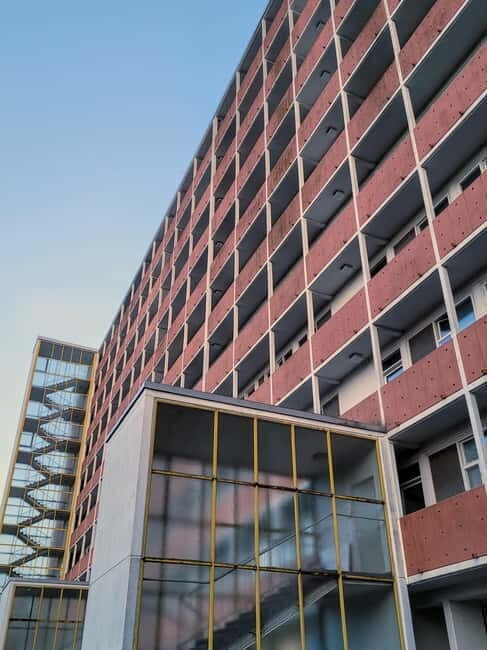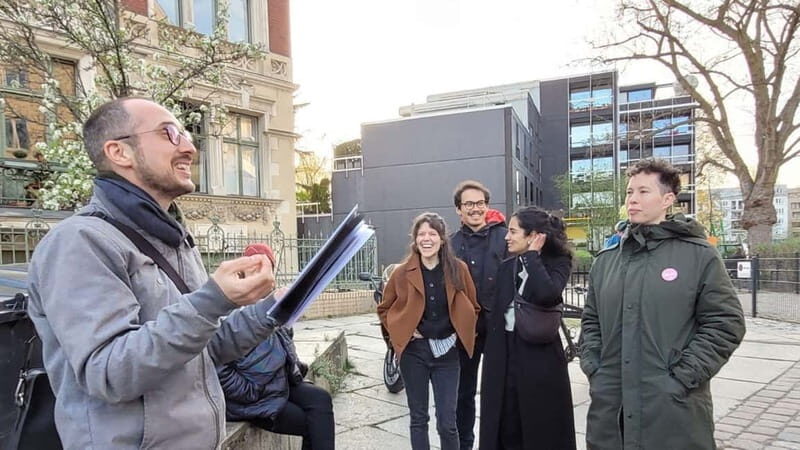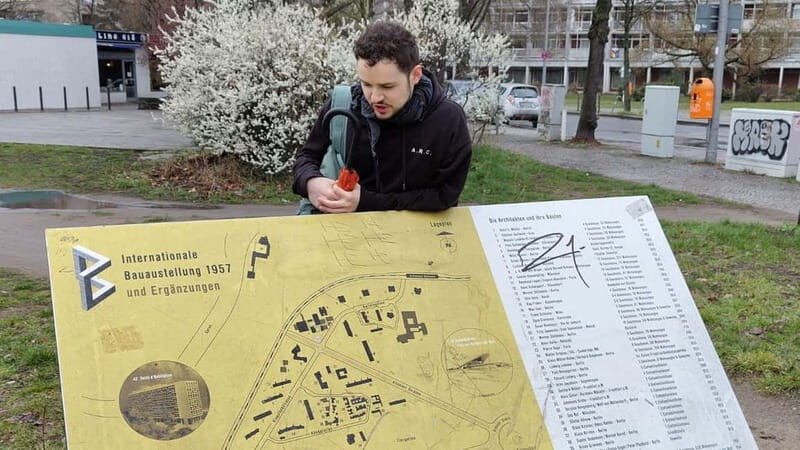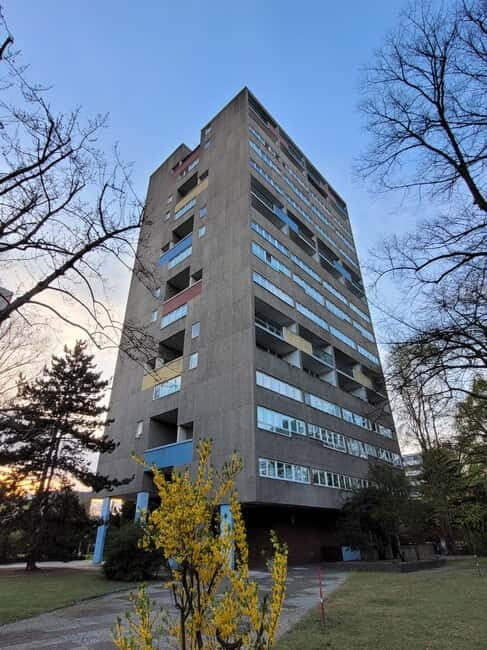Imagine walking through a neighborhood that’s part history lesson, part architectural masterpiece, and part Cold War showcase—all in just two hours. That’s what you get with the Modernist Architecture Tour in the Hansaviertel, a guided stroll that begins at the Berlin-Tiergarten S-Bahn station and winds through one of the city’s most surprising districts. Led by knowledgeable guides, you’ll explore a neighborhood that’s seen dramatic transformations from 19th-century villas to postwar modernist icons. The tour is typically scheduled for about 2 hours—perfect for a quick but meaningful dive into Berlin’s layered past—and costs are reasonable, especially considering the depth of stories you’ll hear.
What we love about this experience is how it combines architectural brilliance with social history, offering both visual delights and powerful narratives—like the Jewish community memorial and the story of how postwar rebuilding was driven by Cold War ambitions. Plus, the chance to see landmark designs by figures like Gropius, Niemeyer, and Aalto makes this a truly inspiring walk for anyone interested in 20th-century architecture or Berlin’s cityscape.
A potential consideration is that it’s a walking tour, so good shoes are a must, and it’s not ideal for those with mobility issues. Also, since the tour covers a lot of history, some of the stories and details might be quite dense, so it’s best suited to curious travelers who enjoy a mix of history, architecture, and social context. This tour is especially well-suited for those who enjoy learning about how architecture reflects political and social ideologies—perfect for history buffs, architecture enthusiasts, or anyone wanting a different perspective away from Berlin’s more famous landmarks.
Key Points

- Architectural Highlights: See modernist designs by Gropius, Niemeyer, and Aalto, created during West Berlin’s postwar rebuilding.
- Historical Depth: Learn about Berlin’s Jewish community and its destruction during Nazi rule, as well as Cold War influences on urban development.
- Neighborhood Charm: Discover the contrast between 19th-century villas and Cold War concrete, all within a leafy, tranquil setting.
- Expert Guides: Benefit from knowledgeable guides who weave stories about architecture, residents, and history into a lively walk.
- Authentic Experience: Walk through a neighborhood that’s both a showcase of modernist ideals and a symbol of Berlin’s resilience and reinvention.
- Accessibility: The tour is wheelchair accessible and suitable for ages 14 and up, making it inclusive yet focused on historical depth.
An In-Depth Look at the Modernist Architecture Tour in Berlin’s Hansaviertel

Walking into the Hansaviertel for this two-hour tour feels a bit like stepping into a living architectural museum. The district, situated between the Spree River and the Tiergarten, is renowned for its postwar modernist buildings. These structures were not only designed to be visually striking but also to symbolize a new, optimistic vision of urban life during a tense Cold War era.
Planning more time in Berlin? We've covered other experiences worth considering.
Starting Point: A Convenient Meeting Spot
The tour kicks off at the Biergarten der Tiergartenquelle, right next to the Berlin-Tiergarten S-Bahn station. This spot is easy to find, marked by the guide’s orange umbrella, and offers a relaxed beginning to what promises to be a fascinating walk. The choice of starting here is practical for travelers arriving by train, and the nearby beer garden adds a local touch—perfect if you want to grab a quick coffee or snack beforehand.
The Old and Elegant Hansaviertel
Initially, the tour takes us through the neighborhood’s early days, when it was a middle- and upper-class enclave. You’ll see 19th-century villas with manicured gardens and elegant facades—reminders of a more genteel Berlin. We loved the way the guide, Morgan, brought these buildings to life, sharing stories of some of the district’s notable residents like Rosa Luxemburg and Käthe Kollwitz. These stories connect the neighborhood’s past to its present, showing how it was once a hub of intellectual and artistic life.
The tour then slows down at a somber but important Jewish community memorial, marking a neighborhood that was decimated during Nazi persecution. This poignant stop emphasizes the profound social and political upheavals that have shaped Berlin, adding emotional weight to the walk.
The Cold War Rebirth: Interbau 1957
The real highlight begins when we arrive at the site of Interbau 1957, an ambitious international architecture exhibition intended to reimagine urban living for a divided Berlin. Here, the neighborhood was transformed from rubble into a showcase of modernist design—a symbol of hope and resilience.
You’ll admire bold buildings by giants of architecture, such as Walter Gropius, Oscar Niemeyer, and Alvar Aalto. The guide explained the philosophies behind their designs—how each architect aimed to shape not just the cityscape but the way people would live in and experience their environment. You’ll see buildings that are elegant, experimental, and sometimes provocative—a visual confession of postwar optimism and technological progress.
More Great Tours NearbyWhat These Buildings Represent
This segment of the tour reveals how architecture during this period was more than aesthetics; it was about promises of a better life and social progress. For instance, Niemeyer’s playful curves contrasted sharply with traditional Berlin architecture, offering a glimpse into how modernism challenged convention.
Our favorite part was hearing how these structures still evoke a sense of modernity, despite being over 60 years old. The guide clarified that while some buildings may feel dated, many still influence contemporary design and urban planning—proof of their lasting impact.
Social, Political, and Architectural Stories Intertwined
Throughout the walk, stories emerge—not just about buildings, but about residents, resistance movements, and urban renewal. We loved the detail that the tour is not just about architecture but about the neighborhood’s social fabric: how a city rebuilds itself and how architecture reflects political ideologies.
Practical Aspects of the Tour
The tour is manageable for most, lasting about 1.5 hours of guided walking plus the initial meeting. It’s wheelchair accessible and recommended for those 14 and older—an inclusive experience that respects diverse mobility needs. The group size is usually small enough to allow questions, which our guide Morgan handled expertly, responding with lively stories and detailed insights.
You’ll need comfortable shoes for walking, and it’s wise to bring water, especially in warmer weather. Since food and drinks aren’t included, you might want to grab a snack at the start or end—perhaps enjoy the local beer garden or nearby cafes.
The Value of the Experience
Compared to other Berlin architecture tours, this one provides a rare blend of history, social commentary, and design. Entry fees for museums aren’t included, but the value lies in the storytelling and the tangible experience of walking through Berlin’s modernist legacy. It’s an affordable way to see architecture that isn’t always on the typical tourist radar and to gain a deeper understanding of Berlin’s postwar story.
Who Will Love This Tour?
This experience is ideal for travelers who enjoy architecture, history, or urban planning. If you’re curious about how political ideologies shape cityscapes or want to see a neighborhood transformed by Cold War ambitions, this tour offers both sights and stories that will satisfy your interests. It’s perfect for those who appreciate detailed narratives and are willing to walk a fair bit to see Berlin’s lesser-known but deeply significant districts.
The Sum Up

The Berlin Modernist Architecture Tour in the Hansaviertel offers a thoughtful, engaging glimpse into how architecture and history intertwine. It’s a walk through Berlin’s recent past—an era marked by innovation, upheaval, and hope—and a chance to see designs that still influence modern architecture today. The guides bring history alive with stories of social change, resistance, and architectural vision, making this a memorable experience for curious travelers.
If you’re interested in seeing Berlin from a different angle—beyond the Brandenburg Gate and Museum Island—this tour provides a rewarding alternative. It suits those who enjoy architecture, history, or simply walking through neighborhoods with a story to tell. Plus, the accessible setup and reasonable price point make it a practical choice for almost any traveler eager to learn more about Berlin’s complex and inspiring landscape.
Frequently Asked Questions

How long is the tour?
The guided walk lasts approximately 1.5 hours, with the entire experience around 2 hours including meeting time.
Where does the tour start and end?
It begins in front of the Berlin-Tiergarten S-Bahn station, next to the Biergarten der Tiergartenquelle, and concludes at Hansaplatz.
Is the tour suitable for people with mobility issues?
Yes, the tour is wheelchair accessible, but it involves walking on streets and pavements, so comfortable shoes are recommended.
What should I bring?
Comfortable walking shoes and water are advised. Food and drinks are not included, so plan accordingly.
Are children allowed?
While there’s no strict age limit, the tour is recommended for ages 14 and up, as it involves historical and architectural content.
Do I need to book in advance?
Yes, reservations are recommended, and you can cancel up to 24 hours in advance for a full refund.
What languages are offered?
The tour is conducted in German and English, making it accessible for most travelers.
In all, if you’re seeking a tour that marries architecture, history, and social stories in a manageable and engaging way, this one in Hansaviertel is well worth your time.
You can check availability for your dates here:More Tours in Berlin
- Berlin: Private Highlights Walking Tour
- Berlin: Fotografiska Entry plus Guided Tour (English)
- Berlin: 3-Hour Guided Small Group Fat Tire E-Scooter Tour
- Berlin: Hitler’s Berlin The Rise & Fall Guided Walking Tour
- Berlin: Top Sights Guided E-Scooter Tour
- Berlin: “The Humboldt Forum for Newbies” Guided Tour
More Tour Reviews in Berlin
- Berlin: Private Highlights Walking Tour
- Berlin: Fotografiska Entry plus Guided Tour (English)
- Berlin: 3-Hour Guided Small Group Fat Tire E-Scooter Tour
- Berlin: Hitler’s Berlin The Rise & Fall Guided Walking Tour
- Berlin: Top Sights Guided E-Scooter Tour
- Berlin: “The Humboldt Forum for Newbies” Guided Tour
More Berlin experiences we've covered
- Berlin: Private Highlights Walking Tour
- Berlin: Fotografiska Entry plus Guided Tour (English)
- Berlin: 3-Hour Guided Small Group Fat Tire E-Scooter Tour
- Berlin: Hitler’s Berlin The Rise & Fall Guided Walking Tour
- Berlin: Top Sights Guided E-Scooter Tour
- Berlin: “The Humboldt Forum for Newbies” Guided Tour
- Berlin Express: Private 1-Hour E-Rickshaw Ride
- Berlin by Night: Private Photoshoot at Illuminated Cityscape
- Berlin: World Clock to World Heritage & World War 2 Walk
- Berlin: Cold War Walking Private Tour with Guide
- Berlin: Classical concerts at Glienicke Palace
- Berlin: East Side Gallery and Cold War Segway Tour
